Eco-Friendly Upcycling: Clever Methods for Reimagining Trash
In today's world, sustainability is more important than ever. As our landfills overflow and natural resources dwindle, eco-friendly upcycling is gaining popularity as a creative and practical way to reduce waste. Not only does upcycling cut down on the trash in our environment, but it also offers the opportunity to inject new life into old objects, making eco-friendly living both functional and stylish.
What is Eco-Friendly Upcycling?
Eco-friendly upcycling refers to the process of transforming discarded items or materials into new, valuable products--without breaking them down into raw materials. Unlike recycling, which typically uses energy and water to process waste, upcycling reduces environmental impact and energy usage by directly reusing existing items in innovative ways. This practice not only diminishes our ecological footprint but also sparks creativity, encourages individuality, and saves money.

Benefits of Upcycling Waste--Why Should You Reimagine Trash?
Why is upcycling so important? Let's dive into the numerous benefits:
- Reduces landfill waste: Every item upcycled is one less item polluting our planet.
- Conserves resources: By reusing materials, we decrease the demand for new raw resources.
- Decreases pollution: Fewer items in landfills mean reduced methane and harmful leachates.
- Promotes creativity: Upcycling unique items inspires artistry and personal expression.
- Supports local economies: Many small businesses thrive by selling upcycled goods.
- Saves money: Creating functional items from waste is cost-effective and budget-friendly.
Popular and Clever Methods for Eco-Friendly Upcycling
There's a wealth of inventive ways to give "trash" a second chance. Experimenting with eco-friendly upcycling methods not only helps the planet but also results in truly one-of-a-kind products. Here are some clever ideas to get you inspired!
1. Upcycling Glass Jars and Bottles
Empty jars and bottles are some of the most versatile items for upcycling. Their sturdy material and transparent finish make them perfect for a wide range of imaginative uses:
- Luminaries or lanterns: Insert a tealight or fairy lights for enchanting indoor or outdoor lighting.
- Storage containers: Use jars to organize spices, small hardware, craft supplies, or bathroom essentials.
- Planters: Create a stylish herb garden on your windowsill using glass containers.
- Decorative vases: Paint or embellish glass bottles for unique flower displays.
- Soap dispensers: Fit a pump onto a glass bottle to make a chic and eco-friendly soap dispenser.
2. Revamping Old Furniture
One of the most popular examples of eco-friendly upcycling is transforming tired furniture into trendy, practical pieces. With a bit of sanding, a new coat of paint, or some creative repurposing, you can breathe fresh life into unwanted pieces:
- Wooden pallets: Construct coffee tables, bookcases, or even bed frames from discarded pallets.
- Chairs and stools: Refurbish broken or outdated seating by reupholstering and painting.
- Dressers and cabinets: Convert an old dresser into a bathroom vanity or a TV console.
- Doors and windows: Convert an old door into a stylish headboard or transform window frames into decorative photo displays.
3. Transforming Textile Waste
The fashion industry generates huge amounts of textile waste every year. Upcycling clothes and fabric scraps is a fantastic method for reimagining trash:
- Tote bags: Turn old T-shirts and jeans into eco-friendly shopping bags.
- Rag rugs: Weave or braid colorful rag rugs from unwanted garments.
- Patchwork quilts: Combine fabric scraps into cozy, unique quilts.
- Pet beds: Fill old pillowcases with shredded fabric for DIY pet cushions.
- Scrunchies and accessories: Use leftover fabric for headbands, scrunchies, or jewelry.
4. Creative Uses for Plastic Containers
Plastic is one of the most persistent forms of waste. With some creativity, you can upcycle plastic items and keep them from polluting the earth:
- Planters: Cut plastic bottles to create mini planters for herbs or succulents.
- Bird feeders: Hang cut and decorated bottles on trees to attract birds to your yard.
- Organizer boxes: Use cleaned yogurt cups or food tubs for organizing small items.
- Vertical gardens: Use multiple plastic bottles to design a vertical gardening system for balconies or tight spaces.
5. Paper and Cardboard Reimagination
Although paper products are biodegradable, upcycling paper and cardboard is a more eco-conscious choice:
- Paper mache art: Build figurines, bowls, or decorative objects from newspaper and wallpaper paste.
- Gift packaging: Turn cereal boxes or cardboard tubes into pretty gift boxes or tags.
- Wall art: Craft 3D wall hangings and collages from old magazines.
- Seedling pots: Use toilet paper rolls to start seedlings for your garden.
6. Electronic Waste Repurposing
Electronic waste is a 21st-century challenge. Instead of tossing out obsolete gadgets, try some of these clever upcycling methods:
- Clock faces: Transform old CDs or hard disks into eye-catching wall clocks.
- Circuit board jewelry: Create funky necklaces or earrings from colorful circuit boards.
- Light fixtures: Use broken computers or television parts for industrial-style lamps.
- Keychain fobs: Remove keys from unused keyboards to make personalized keychains.
Tips for Successful Eco-Friendly Upcycling Projects
- Start small: Begin with a simple project before tackling larger items.
- Gather inspiration: Search online platforms (Pinterest, Instagram) for creative upcycling ideas.
- Collect tools: Common tools like glue, paint, scissors, and screwdrivers help with most projects.
- Clean materials: Always wash and sanitize items before reusing.
- Think outside the box: Let your imagination lead you--there are no limits to upcycling creativity!
Eco-Friendly Upcycling in the Community
Upcycling isn't just for individuals--it's a growing movement among artists, businesses, and local governments. Communities around the world are organizing upcycling workshops, swap meets, and repair cafes to encourage collaborative sustainability. Schools are involving students in creative repurposing activities, teaching future generations the value of resourcefulness and environmental consciousness.
Upcycled Art Installations
Public art projects often use discarded materials to create sculptures and murals, transforming community spaces and raising awareness about waste. For example, giant fish sculptures made from ocean plastic, or vibrant mosaics composed of broken ceramics, turn trash into visual statements about the need for sustainability.
Upcycling Business Initiatives
Many innovative businesses are now specializing in upcycled products. From fashion labels that rework vintage clothing, to furniture makers using reclaimed wood and metals, upcycling is becoming a profitable industry. By choosing to shop from such businesses, consumers can directly support sustainability and reduce their own environmental impact.

How to Make Upcycling a Lifestyle
If you want to integrate eco-friendly upcycling into your life, start with these easy steps:
- Reframe your mindset: See value in discarded materials, not just waste.
- Educate yourself: Research which items are safe and best-suited for upcycling.
- Get creative: Experiment and innovate with your own upcycling projects.
- Collaborate: Invite family, friends, or neighbors to join in group upcycling ventures.
- Donate or sell: Give your upcycled creations new homes or consider starting a small side business.
Upcycling for Kids and Schools
Introducing children to clever upcycling methods is a fun and educational way to teach about the environment. Schools can run upcycling workshops; children can make pencil holders from tin cans or start a bug hotel with old wood and bamboo, fostering imaginative play while learning how to care for the planet.
Conclusion: Trash is Treasure in the World of Eco-Friendly Upcycling
Eco-friendly upcycling is much more than a sustainability buzzword. It's a creative revolution that encourages us to view "waste" through a new lens, unlocking its potential for beauty, utility, and innovation. By incorporating clever upcycling methods into our lives, we can reduce our environmental impact, save money, and inspire those around us. Whether you're a well-practiced upcycler or just getting started, the world of upcycling is filled with endless opportunities to reimagine trash as treasure.
Ready to Begin Your Own Upcycling Journey?
- Start by setting aside interesting items you might have thrown away.
- Browse or join local upcycling workshops and online communities.
- Share your eco-friendly upcycling projects with friends and family to spread environmental awareness!
Remember: with a little imagination and effort, you can help preserve the planet--one upcycled creation at a time.
